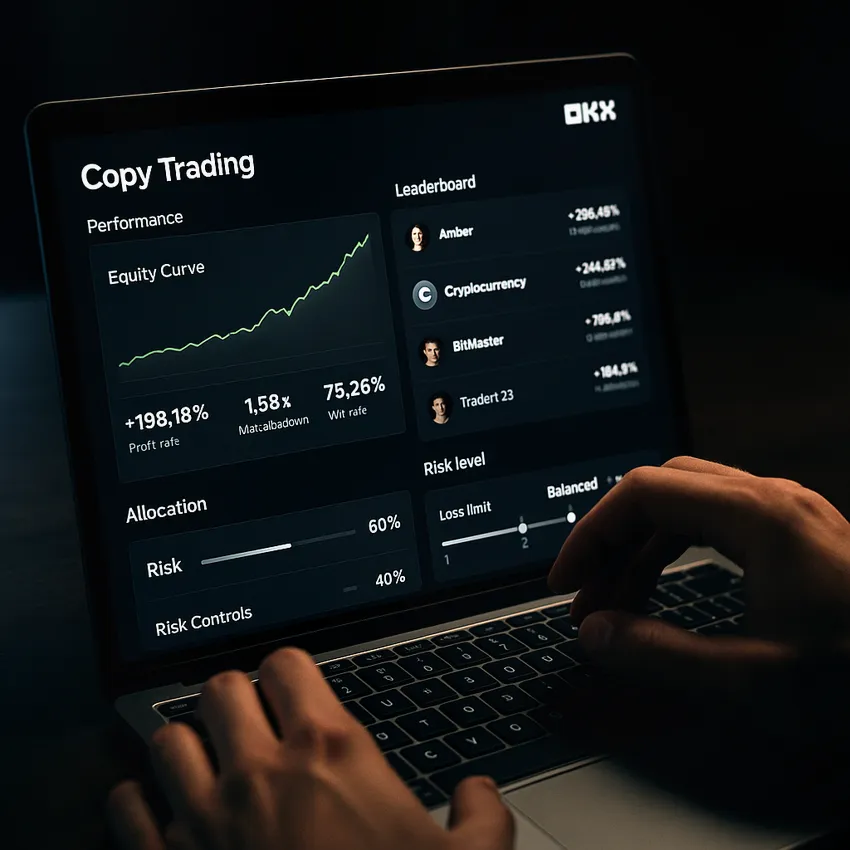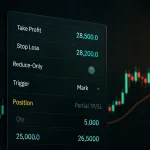If you’re curious about copy trading on OKX but don’t know where to begin, you’re in the right place. This guide walks you through OKX Copy Trading from zero to your first mirrored position, with practical checkpoints for risk, fees, and picking lead traders you actually want to follow. I’ll sprinkle in a few hard-earned lessons, data-backed tips, and a clear setup sequence you can repeat whenever you add or adjust strategies.
Quick heads-up: this is educational, not financial advice. Crypto is volatile. Manage risk first.
Strong start offer: you can open your account and access copy trading with this invitation link — Join OKX with code CRYPTONEWER. Using code CRYPTONEWER can unlock better onboarding perks and helps support this resource.
Why OKX for Copy Trading
OKX has grown into a feature-rich exchange with deep derivatives liquidity, strong order routing, and a social layer for discovering and following lead traders. What sets OKX Copy Trading apart:
- Solid trader discovery: transparent stats for win rate, PnL, drawdown, AUM, and follower counts.
- Position-level controls: set allocation caps, stop loss, and, in many cases, trailing stops per copied strategy.
- Versatility: copy spot and derivatives traders, including perpetual futures specialists.
- Risk rails: you can limit total exposure, max contracts, and per-trader allocation.
- Mobile and web parity: the copy trading dashboard is accessible in both environments with similar feature sets.
If you’ve ever struggled to keep up with markets, copy trading can compress the learning curve — but only if you stick to rules that protect your capital.
What Is Copy Trading, Exactly?
Copy trading mirrors another trader’s positions in your account automatically. When the lead trader opens, adds to, reduces, or closes a position, your account does the same in proportion to your allocation and your risk settings. You stay in full control: you can pause, close, or adjust at any time.
Key terms to understand on OKX:
- Lead Trader: The person whose trades you mirror.
- Follower: You — the copier of trades.
- Allocation: The amount of capital you commit to copy a lead trader.
- Profit Share (Performance Fee): A % of profit you pay to the lead trader (and possibly the platform) when you profit.
- Drawdown: Peak-to-trough decline in equity; a vital risk metric.
Fees and Profit Share on OKX Copy Trading
Fees are straightforward but important:
- Trading fees: Standard maker/taker fees on spot or derivatives apply as your positions are executed.
- Profit share: Lead traders may charge a performance fee on profits you realize, calculated periodically. Check each lead trader’s profile for the rate and calculation cycle.
- Funding and financing: If you copy perpetual futures or margin strategies, you may incur funding payments or interest.
Tip: Compare net performance (after fees) rather than gross PnL. If two traders have similar returns but one charges a higher profit share and uses more leverage (higher risk), the lower-fee, lower-risk trader can be the smarter choice.
OKX Copy Trading: Getting Started in 9 Clear Steps
You can be up and running in under 20 minutes if you follow a checklist. Here’s a clean path:
1) Create your account
– Use this invite link — Create your OKX account with code CRYPTONEWER — then complete identity verification (KYC) as required by your region.
2) Deposit or transfer funds
– Deposit fiat or crypto, or transfer from another wallet. Decide your base copying currency (USDT is common for derivatives, spot varies).
3) Enable copy trading
– Navigate to “Copy Trading” on the OKX app or web. Review the terms, toggle permissions as prompted.
4) Define your risk budget
– Decide a percentage of your total portfolio you’re comfortable risking in copy trading (e.g., 10–30%).
– Split that budget across multiple lead traders to reduce single-strategy risk.
5) Screen for lead traders
– Filter by time frame (90/180/365 days), minimum sample size (number of trades), drawdown, and average leverage.
– Favor traders with consistent equity curves over “moon-shot” charts.
6) Deep-dive each candidate profile
– Metrics to inspect: Win rate, average R/R, max drawdown, longest losing streak, average holding time, PnL by market regime, allocation by asset.
– Confirm reliability: posting cadence, transparent notes, rational position sizing.
7) Start small and diversify
– Allocate a small test amount to 2–4 different strategies (e.g., one trend-following, one mean-reversion, one event-driven). Keep correlation low.
8) Set risk controls per strategy
– Define per-trader max allocation, per-position stop loss, and optional trailing stops.
– If available, set max leverage or contract caps.
9) Monitor and iterate
– Weekly review: performance after fees, realized drawdown vs. your threshold, correlation between copied traders.
– Scale up allocations gradually after at least one full market cycle (e.g., 4–12 weeks of observation).
How to Choose Lead Traders Like a Pro
A clean profile is nice; robust data is better. Here’s a practical framework:
- Time under observation: Prefer 6–12 months of track record. If shorter, reduce allocation.
- Max drawdown threshold: Keep it realistic. A trader with 12–18% max DD is generally safer than someone at 40%+, assuming similar returns.
- Consistency score: Look for steady month-over-month PnL, not one lucky spike.
- Position sizing discipline: Position size should vary with conviction and volatility; avoid traders who always max out.
- Leverage control: Check average and peak leverage. Extreme leverage implies tail risk.
- Strategy clarity: Trend-following, breakout, mean reversion, basis trades, funding capture — know what you’re buying.
- Correlation control: Don’t copy three BTC-perp momentum traders and call it diversification. Mix methodologies and timeframes.
Red flags:
- Low trade count with enormous returns (likely luck or survivorship bias).
- “All-in” leverage behavior during rallies.
- Infrequent or evasive communication.
- Giant follower count without audited or transparent stats.
Risk Management Settings That Actually Matter
- Per-trader allocation cap: Prevents one leader from dominating your portfolio if they go on tilt.
- Global exposure limit: Caps total copy-trade risk across all leaders.
- Stop loss and take profit: Use a rules-based range (e.g., SL at 1–1.5× average true range; TP at 2–3× ATR or based on structure).
- Trailing stop: Lets profits run while locking in gains; ideal for trend followers.
- Max number of open positions: Avoid overtrading and hidden correlation spikes.
- Cooldown rules: Pause copying after a defined sequence of losses.
A practical template for beginners:
- Start with 2–3 leaders; cap any single leader at 10–15% of account equity.
- Set per-position SL at 1–2% equity risk and a trailing stop once unrealized gains >1.5R.
- Weekly rebalancing; monthly performance review.
Building a Diversified Copy Trading Portfolio on OKX
Consider blending:
- Trend-following derivatives trader (BTC/ETH perp): Captures directional moves with trailing stops.
- Mean-reversion spot swing trader (alts): Buys oversold pullbacks; smaller size, wider SL.
- Event or funding-based trader: Exploits funding differentials or news catalysts with tight risk.
Track correlation:
- Measure whether your copied leaders lose or win together.
- Aim for <0.6 correlation across leaders where possible, using different timeframes and markets.
Monitoring and Maintenance
- Weekly dashboard check: Compare realized PnL vs. expected, drawdown trends, and fee impact.
- Performance after fees: Keep an eye on profit share and funding; the net number matters.
- Stop copying triggers: Breach of your max DD threshold, erratic leverage spikes, or strategy drift.
- Communication: Favor leaders who publish rationale and updates.
Advanced Tips Most Beginners Miss
- Stagger entries: If a leader opens a large position in thin liquidity, consider a manual partial fill in your account to reduce slippage.
- Slippage and latency: High-volatility events can cause price gaps. Set realistic expectations for fills versus the leader’s execution.
- Capital buffers: Maintain 10–20% cash buffer to handle margin, funding, or new opportunities.
- Avoid overfitting to recent returns: The last 30 days often mislead. Use longer windows.
- Use scenario testing: Ask, “What if the leader hits their historical max DD tomorrow?” Size so you can live through it.
Common Mistakes to Avoid
- Copying too many leaders at once and ending up with a closet-index of the same trade.
- Ignoring fees: Performance fees and funding can erode headline returns.
- Chasing top-performers of the week: They often revert.
- No exit plan: Define when you reduce or stop copying a leader.
- All-in on one market: If all your leaders focus on BTC, your portfolio is effectively one bet.
Quick Start Checklist
- Create account: Join OKX with code CRYPTONEWER
- Fund your account and choose base currency.
- Set a copy-trading risk budget (e.g., 20% of portfolio).
- Pick 2–4 leaders with solid DD control and consistent returns.
- Cap allocation per leader (10–15%).
- Turn on stop loss and trailing stop per strategy.
- Review weekly; rebalance monthly.
Frequently Asked Questions
Q: Is copy trading passive income?
– It can be semi-passive, but it’s not set-and-forget. You must monitor risk, fees, and strategy drift.
Q: What’s a reasonable starting amount?
– Start with an amount small enough that a 10–20% drawdown wouldn’t derail you — then scale with evidence.
Q: How do profit-share fees work on OKX?
– If enabled by the leader, a percentage of your net profits for the period is paid out. Always verify the rate and schedule on the leader’s profile.
Q: Can I stop copying mid-trade?
– Yes. You can pause copying or close individual positions anytime. Liquidity and spreads still apply.
Q: Does copy trading work in bear markets?
– If the leader’s strategy accounts for volatility and trend changes, yes. That’s why drawdown control and trailing stops matter.
Q: How many leaders should I copy?
– For most, 2–4 with distinct strategies is a prudent start. More than 5 often increases correlation and complexity.
Practical Evaluation Template You Can Reuse
When you shortlist a leader, score each category 1–5:
- Time under observation (prefer ≥6 months)
- Max drawdown (lower is better, but context matters)
- Win rate and average R/R (risk-reward)
- Leverage discipline
- Position sizing logic
- Communication and transparency
- Strategy diversification potential vs. your current leaders
Only allocate to leaders with an overall score ≥22/35. Keep journaling results and revisit scores monthly.
Implementation Notes for Derivatives Copying
- Funding rates: Monitor funding if copying perpetual strategies; net returns can shift with elevated funding.
- Margin mode: Know whether trades are isolated or cross margin; set buffers accordingly.
- Liquidation risk: Follow leaders who keep liquidation prices far from entry and use planned exits.
- Volatility windows: Expect wider slippage during CPI prints, FOMC, or major listings; tighten size or pause copying during known events if your leader is hyperactive.
Security and Operational Hygiene
- Enable 2FA and withdrawal whitelists.
- Separate long-term holdings from your copy-trading sub-account.
- Keep a small cash buffer for margin and fees.
- Document your rules so you don’t make emotional decisions under stress.
Where to Begin Right Now
If this is your first run at OKX Copy Trading, keep it simple:
- Open your account via OKX signup with code CRYPTONEWER.
- Fund, allocate 10–20% to copy, and choose 2–3 leaders with low drawdowns and consistent, boring returns.
- Turn on stop loss and, when available, trailing stops.
- Review weekly; scale only after several weeks of stable results.
OKX Copy Trading can be a powerful tool when approached like a portfolio manager, not a gambler. Use data, respect risk, and let process compound the edge. And if you found this guide useful, consider sharing the invite — Start on OKX with code CRYPTONEWER — to help friends onboard with the same guardrails you’re using.





